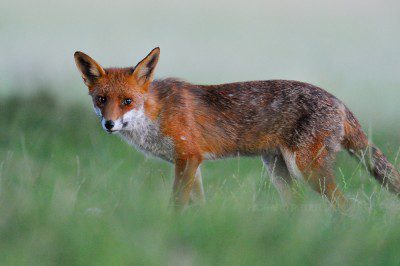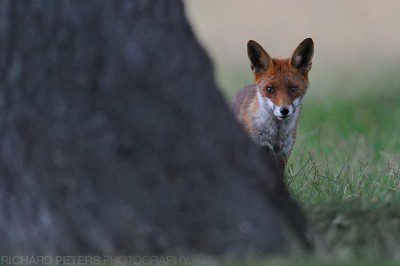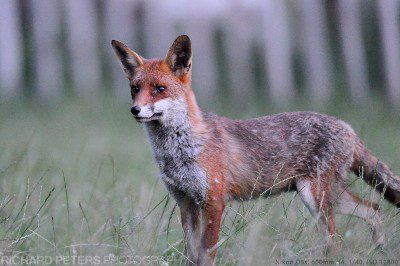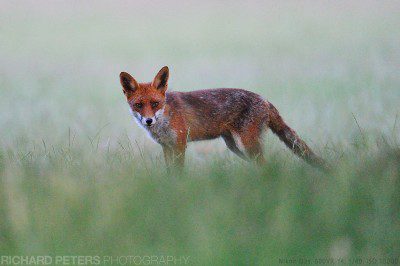I’ve always said I’d rather have a sharp noisy picture than a soft clean one. It’s one of the sayings I’ve always stuck to, however I rarely need to put it to the test. But recently a fox stumbled in front of my lens at dusk on a cloudy summers evening and on this occasion, rather than sit and watch I decided that despite the light dropping off rapidly I’d keep shooting until it was too dark for the camera to auto focus. So, although I may not have got the cleanest images, I did get some images. And that’s what counts, not just to me, but hopefully to you too!

Nikon D3s, 600 VR + 1.4x, 1/40, f5.6, ISO 10000
I’m under no illusion of course the the D3s helps big time here with it’s stunning high ISOs, but more important than that I wanted to just try and get across my thought process that sometimes it’s ok to have an image that isn’t smooth as silk, and that you shouldn’t be afraid to push the boundaries and see if you can keep on shooting for a little longer than you usually would by upping your ISO. You might not get any award winning images (although you never know!) but you might still get something that is good enough to print because don’t forget noise doesn’t show up in print half as much as it does on the computer screen!.
HIGH ISO: GOOD LIGHT v BAD LIGHT
I’ve used high ISO in the past in relative bright light to get a faster shutter speed or more depth of field, and it does come in very handy. In bright light, you can get away with a lot more than you can in low light and that is why here, I’ve used it for what you’d naturally assume it should be used for, shooting in very low light. The shots here were processed with the following:
1) In camera noise reduction set to low
2) Levels, contrast and saturation in photoshop
3) Sharpening, only applied to the fox
4) I adjusted the white balance on a couple, to warm the image up. But quite liked the ‘twilight’ feel the originals had too.
That’s it. With the exception of this image below:

Nikon D3s, 600 VR + 1.4x, 1/250, f5.6, ISO 10000
I did reduce the colour noise in photoshop for that image because I got the exposure very wrong and under exposed far too much as the shutter speed was set too high. Brightening the image back up highlighted the noise, so, I felt adding more reduction to the foreground out of focus tree trunk was needed.
Of course, the biggest issue here was getting a sharp image, as the shutter speed was slow, the focal length high and the fox was almost constantly on the move!
GETTING THE CORRECT EXPOSURE
The key with shooting at low light and high ISO is to get the exposure correct. Do that you’ll be amazed how much cleaner high ISO images can look. You’ll always notice bright areas show up far less noise than dark area’s, and that is even more important to remember in these extreme situations were the ambient light is almost non existent.

Nikon D3s, 600 VR, 1/40, f4. ISO 12800
I’m under no illusion that of course the Nikon D3s makes this far easier than if I was shooting with another camera. Here’s the thing though, as digital camera’s progress, they are opening up a whole new range of photographic opportunities. Each new sensor brings with it better and better ISO ranges, and with cameras such as the Nikon D7000 (read my review) offering excellent DX noise handling for under £1k, maybe it won’t be too long before even entry level DSLRs offer ISO ranges that make shooting in these extreme lighting scenarios a reality, if needed.

Nikon D3s, 600 VR, 1/40, f4, ISO 10000
Sure, images taken in virtually no light can have a slightly surreal look to them (someone pointed out to me it can almost look like a canvas painting) but it wasn’t ‘that’ long ago the D2x was the king of the Nikon DSLR hill and that was beyond awful at even ISO 800. I know one thing, if the Nikon D4 is as big a leap in quality as the D3(s) was from the D2x, we are in for something very special indeed!
And don’t forget, like I said above, print images out and the noise will show up even less! So don’t be afraid to crank that ISO up once in a while! Who knows, maybe my ‘rather have a sharp noisy image‘ thought process will eventually vanish for good, along with the noise from our camera sensors!








